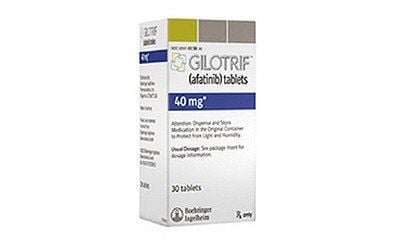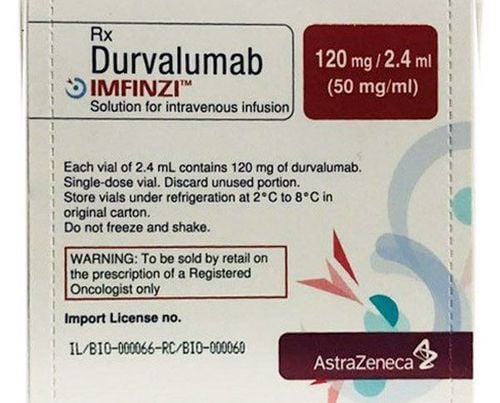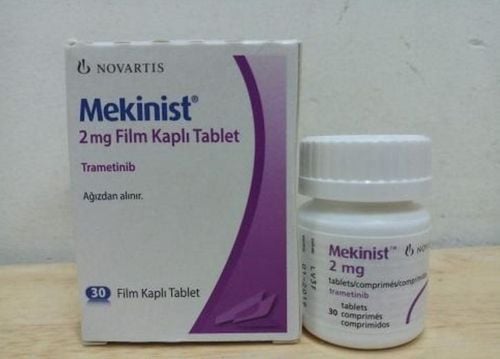This is an automatically translated article.
Lung lobectomy is a highly technical and intensive surgery, usually only performed at central hospitals, indicated for treatment of stage I, II lung tumors; Lung diseases such as bronchiectasis, isolated lung, fungal tumor, benign lung tumor... So what is lobectomy and how is it done? The following article helps you understand more about the advantages of lobectomy in the treatment of lung cancer.
1. What is lobectomy or lobectomy?
Each lung is made up of sections called lobes. There are 3 lobes on the right lung, and 2 lobes on the left lung. Lobectomy is a type of surgery for lung cancer where a lobe of the lung needs to be removed because it contains malignancies. A lobectomy is also done for some other conditions, such as tuberculosis, or for injuries that damage or disrupt major blood vessels near the lungs.
There are two main types of surgery, thoracic incision and laparoscopic surgery. The specialist will decide which type of surgery is the most suitable treatment for the patient, which means that the patient should understand and prepare for the surgery, recovery process, possible complications. out and what after a lobectomy.
A lobectomy is done to remove part of a damaged or diseased lung, usually from lung cancer. In particular, lobectomy is most commonly performed for small cell lung cancer (NSCLC), where the tumor is in only a single lobe.
This procedure is less invasive and preserves more lung function than a pneumonectomy. In contrast, it is somewhat broader than a meniscalectomy, a surgery that removes the tumor and a small amount of surrounding tissue.
2. How is lobectomy performed?
Primary lobectomy is the removal of part of the lung. The lungs are the large organs in the thoracic cavity. The lungs are considered as the air purifier of our body. The lungs help us to have a better respiratory system to take in oxygen and get it into the blood and feed our body. In addition, the lungs are also the organs that filter out all harmful substances from the body such as smoke, pollution, bacteria and viruses.
Lungs are a very important organ in the human body and humans cannot survive without lungs. When deciding which type of lobectomy is most appropriate for the patient's case, the specialist will consider which way to operate based on the following characteristics:
The patient has specific cancer features how the patient's tumor is located the size of the patient's tumor whether the patient's tumor has spread to nearby tissues how well the patient tolerates pain how well the patient's lungs are functioning before surgery The general health of the patient The diagnosis of the specialist. Based on the experience of the specialist doctors, the doctor will follow each procedure and calculation method to come up with the most suitable surgical method for the patient.
Depending on the location and size of the tumor
Although this surgery has a quick recovery, there are times when laparoscopic-assisted thoracic surgery (VATS) cannot be performed. The location of some tumors makes it very difficult to perform VATS, and in these cases, an open lobectomy may be safer and more likely to remove the entire tumor.
In laparoscopic-assisted thoracic surgery, if the surgeon realizes that the cancer is too large to be handled with laparoscopic surgery, they will switch procedures and begin lobectomy with breast surgery.
Each lung is made up of lobes or sections. The left lung has two lobes. The right side has 3 lobes, and is larger.
Lobectomy can be used to treat some cases:
Lung cancer. Tuberculosis (TB). Lung abscess. Fungal infection. Pneumothorax perforation. Tumor but not due to cancer. There are two ways to perform a lobectomy as follows:
Incision surgery: An incision (cut) will be made between the two ribs, from the front of the chest to the back. The lobe is removed through this incision
Laparoscopic thoracotomy: Small incisions are made, During which your surgeon will insert a thoracoscope (a tube with a camera attached). This tube allows the surgeon to see inside the patient's chest and is less invasive than a thoracotomy. Risks associated with lobectomy.
There are risks and side effects associated with lobectomy. Some risks or side effects such as:
Reactions to anesthesia. (Anesthesia is a patient medication used to help the patient sleep during surgery, and to control pain. Reactions may include wheezing, rash, swelling, and low blood pressure.) .) Bleed. Infection . Damage to nearby organs including the heart, lungs, blood vessels, and nerves. Leakage of air in the lungs leads to pneumothorax (Atelectasis.) Pus forms in the space between the lungs and the chest wall of the patient. Pain for days, may be chronic. Bronchopleural fistula (abnormal connection of the bronchi and pleural space), which can lead to intrathoracic effusion. There is air or gas in the chest cavity.
3. Things to consider after lobectomy surgery.
3.1. How is recovery? Recovery from a lobectomy will depend on the extent and type of surgery you've had. Usually, a hospital stay of 5 to 10 days is required to monitor the patient's health condition.
The patient will be instructed on how to care for the incision, drainage and will be carefully instructed before discharge. The patient will be instructed to use oxygen if the patient has a need for oxygen.
The medical team will educate the patient about the medications you will be taking, such as medicines for pain, blood clotting, infection and prevention of constipation, or other conditions.
The specialist will instruct the patient on what to do or limit after surgery.
Take medicine as prescribed. Keep your incision clean and dry. Take care of the incision according to the instructions. Perform breathing exercises as directed. Do not lift heavy loads until you are fully recovered. Avoid contact with people with colds, flu or other respiratory infections, secondhand smoke, chemical fumes or environmental pollution. Avoid smoking and secondhand smoke. If you want help quitting, talk to your provider. Use supplemental oxygen as directed. 3.2. When to call your health care team: Fever. Chills or any other signs of infection. Pain, redness, swelling, discharge or bleeding at the patient's incision Shortness of breath, cough with or without green, yellow or bloody mucus, shortness of breath or pain on breathing. Chest pain (new or persistent). Nausea or vomiting. 3.3. Call the doctor immediately when the patient is coughing up blood (more than a teaspoon) or the patient has a large amount of brown sputum accompanied by blood.
Dizziness, fainting or unconsciousness. Irregular heartbeat. The surgical dressing is soaked with blood or your incision has split open that is swollen, red, or oozing pus. Chest pain. Swelling, redness, heat, pain, or tenderness in the leg or calf. 3.4. How can I take care of myself? The patient needs care and help with daily tasks until the patient recovers. Or until the re-examination, the doctors concluded that the patient had recovered as normal.
Make sure to take medication as prescribed to prevent pain, infection or constipation. Call your doctor if you notice any unusual symptoms.
There are many ways to relieve constipation after surgery. Patients can change their diet, drink, can drink more water. You should consult your doctor before you want to take constipation medications.
Deep breathing and rest can help the patient better control pain and keep the patient's lungs healthy after anesthesia and promote good lymphatic drainage. Try to do deep breathing and relaxation exercises a few times a day for the first week or when you notice yourself getting more stressed.
Example of relaxation exercise: While sitting, close your eyes and take 5-10 deep breaths. Relax your muscles. Slowly roll .
How is the recovery process?
Healing after surgery takes some time. If the patient has surgery, the person has surgery by incision method, the patient may have to stay in the hospital for a few weeks, the patient will be discharged earlier if the surgery is done by laparoscopic method.
Things to watch out for:
Pain: Most people experience discomfort for the first few months after surgery. You will get them when you run out of pain relievers, but you will take them less over time. Patients should regularly bathe with warm water to help relieve muscle pain. Fatigue: You will feel tired and short of breath for the first few days. And will be in remission after a few weeks. Constipation: Pain relievers and patients not moving, being active will lead to constipation. After the patient no longer needs to take painkillers, the constipation will also improve, the patient can consult the doctor before taking the laxatives and stool softeners prescribed by the doctor. Exercise: You will need to walk every day to regain strength and help your lungs get stronger.
Please dial HOTLINE for more information or register for an appointment HERE. Download MyVinmec app to make appointments faster and to manage your bookings easily.
References: oncolink.org, verywellhealth.com













